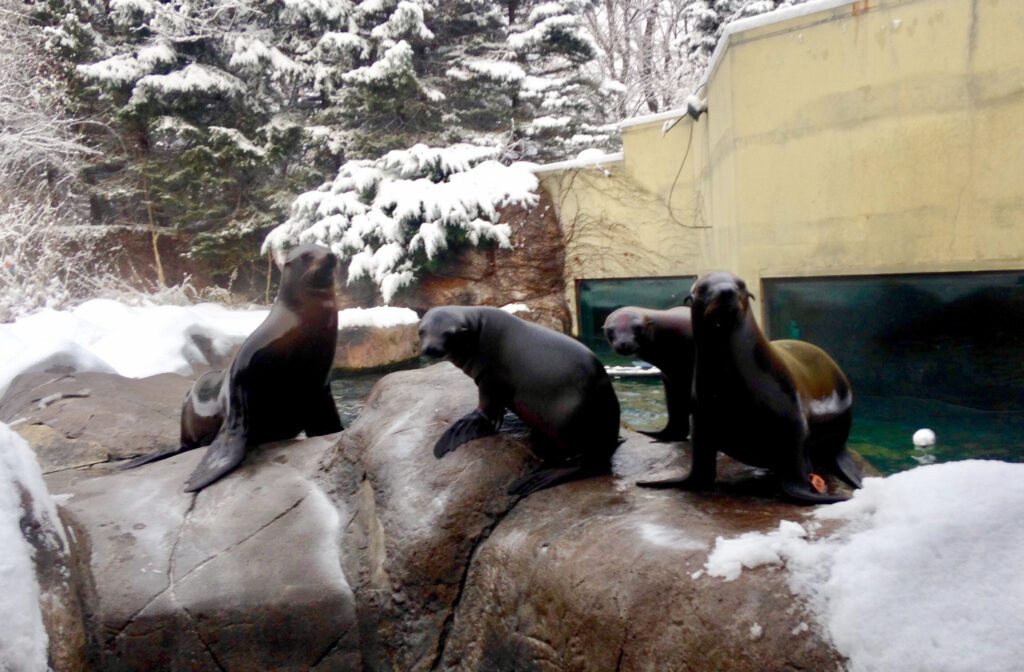January 16, 2018
In the beginning of November, Seneca Park Zoo welcomed two young female California sea lions; Mary Lou and Daley, from SeaWorld Orlando. General Curator David Hamilton and I, flew to Orlando, Florida and spent three days learning about Mary Lou and Daley, as well as preparing for a long trip back to Rochester. SeaWorld trainers shared any knowledge they had about each of the girls, including insight into their personalities. We were also able to watch a few feeding and training sessions. The trip itself only took three days, but planning for their arrival started several months before that.
Our resident sea lions, Lily and Bob, had been living together in Rocky Coasts since Bob’s birth last June. Bob voluntarily weaned himself from his mother at an early age and had bonded with staff, but had never experienced another sea lion. Lily has lived with other sea lions, but her laid back personality changed after she gave birth and she was very protective of Bob. The sea lion staff was fairly certain that Bob would get along well with Mary Lou and Daley, but we didn’t know if Lily would allow anyone to be near Bob. Our concern was that she would try to protect Bob and show some aggressive behavior towards the new girls, as well as the keeper staff.Before Mary Lou and Daley arrived, lots of information was shared between Seneca Park Zoo and SeaWorld. We learned when the girls were born, who they currently lived with, who their parents are, how much they weighed, and their current diets. The vet staff was consulted and we had sea lion staff meetings to discuss how we would handle things once the girls arrived. After all the details were collected, it was decided that Daley and Mary Lou would be placed inside the sea lion behind-the-scenes holding area with the larger pool upon arrival. This would allow them to have access to a heated indoor area with a pool, but also be able to see Lily and Bob through the gates. Lily and Bob would have outside access, the other indoor pool, and the rest of the indoor holding area.A couple days prior to Mary Lou and Daley’s arrival, staff limited access to the larger pool area in our sea lion holding, so that Lily and Bob could adjust to the area not being available to them at all times. This was important, especially for Bob, who spent significant time in there. Additional heaters were hung in three different indoor locations, allowing all the sea lions supplementary heat, since winter was fast approaching and the new additions were used to warmer Florida temperatures.The morning Daley and Mary Lou arrived, staff was ready to help make the transition from SeaWorld to Seneca Park Zoo. Lily and Bob were outside and we gave Mary Lou and Daley access to the pool room. They adjusted fairly well and there was little to no stress observed. Staff offered them food, and then gave Lily and Bob indoor access so they could see each other. Over the next couple days, we observed how the sea lions interacted through the gate and kept a log of any and all behaviors. We also allowed Mary Lou and Daley to explore inside while Lily and Bob were outside so they could become comfortable and familiar with their new surroundings. Three days after their arrival, we kept Lily and Bob separated inside another area and opened the door to the outside. Both Mary Lou and Daley peeked out the door but chose to stay inside. We wanted everything to be as positive as possible, so we allowed them to make the decision to stay where they were most comfortable.Four days after their arrival, we opened all the indoor and outside doors, allowing Daley and Mary Lou to meet Bob and Lily. The introduction could not have gone any smoother! Keeper staff remained with the sea lions inside at first, but ultimately had to exit because Bob was more interested in the keepers than the new sea lions. Within 15 minutes of the introductions, all the sea lions were swimming outside together. Pushing, shoving, chasing, open mouth lunging, and biting are some typical signs of aggression in sea lions. Luckily for us, everything worked out as we hoped it would and we saw no signs of aggression.The behind-the-scenes holding area has three cameras inside and one camera outside, so we can observe their behaviors at all times. This is important because we don’t always know what is going on overnight when sea lion staff isn’t there. One of the ways we were certain that everyone was comfortable with each other was when we saw all the sea lions sleeping next to each other inside. The sea lions were also playing, eating, and interacting with staff, all of which are very good signs that everyone has accepted each other. If I had to rate the sea lion introductions, I would give it an A+!– Kellee Wolowitz, Assistant Curator








